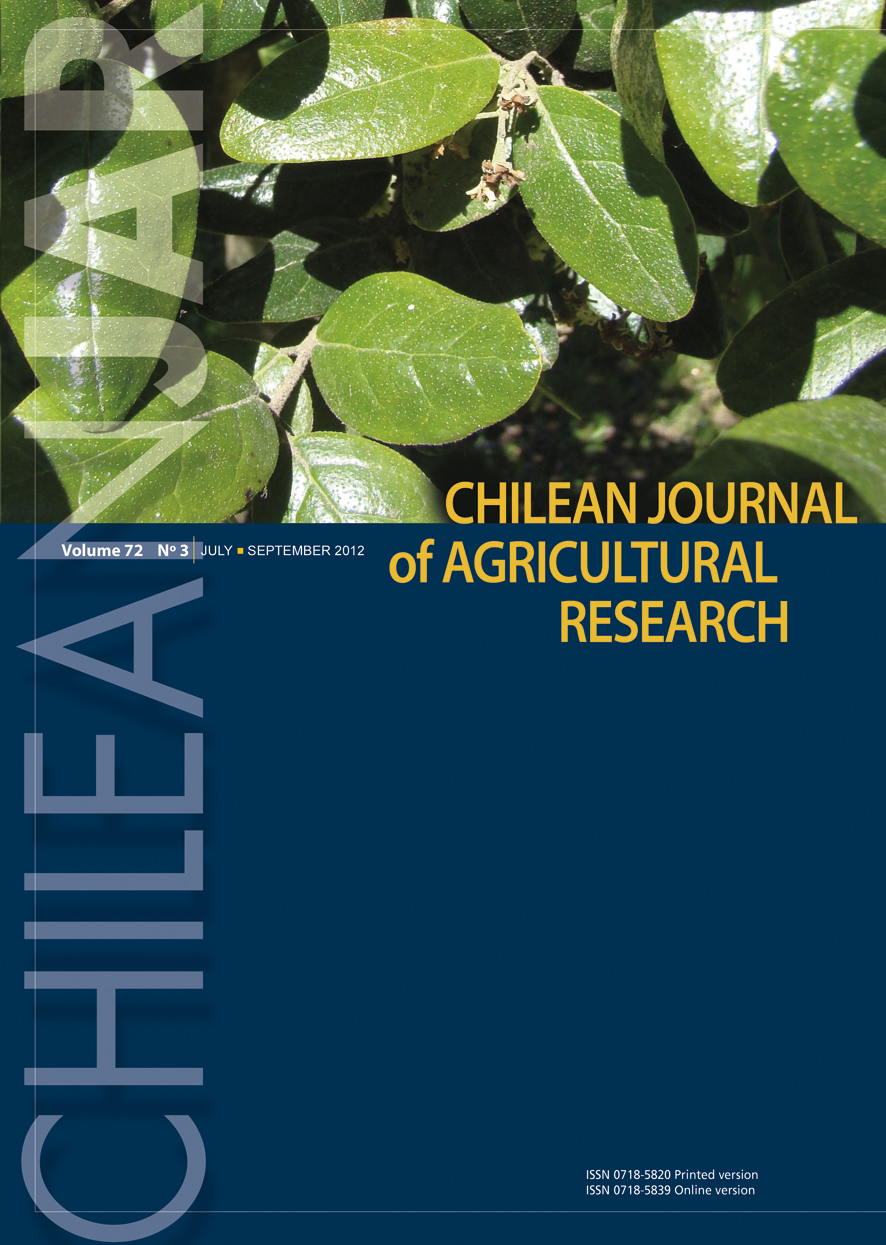
|
Chilean Journal of Agricultural Research
Instituto de Investigaciones Agropecuarias, INIA
ISSN: 0718-5820
EISSN: 0718-5820
Vol. 68, No. 2, 2008, pp. 198-206
|
 Bioline Code: cj08020
Bioline Code: cj08020
Full paper language: English
Document type: Note
Document available free of charge
|
|
|
Chilean Journal of Agricultural Research, Vol. 68, No. 2, 2008, pp. 198-206
| es |
Utilización del modelo dinámico para evaluar el frío invernal en una localidad de clima templado y otra subtropical de Chile.
Pérez, Francisco J.; Ormeño, Juan N.; Reynaert, Bryan & Rubio, Sebastián
Resumen
Se evaluó el frío invernal acumulado en Santiago (33°34' lat. Sur; 625 m.s.n.m.; Región Metropolitana) y Vicuña (30°02' lat. Sur; 643 m.s.n.m.; Región de Coquimbo) durante las temporadas 2005 y 2006 aplicando tres diferentes modelos. El modelo de horas-frío (CH), actualmente empleado como indicador agroclimático en Chile, resultó de poca utilidad para contrastar efectivamente la condición subtropical de Vicuña con la condición templada de Santiago. Al utilizar el modelo de Utah se obtuvieron valores negativos de marzo a mayo e incluso hasta el mes de junio en Vicuña, ya que, precisamente, con este modelo el efecto del frío es anulado por las altas temperaturas. Sin embargo, una modificación de este modelo, denominado Unidades de Frío Positivas (UPF), en que los valores negativos se omiten, mostró diferencias en el frío acumulado entre ambas regiones, pero las diferencias fueron pequeñas y se expresaron sólo a partir del mes de julio en adelante. La aplicación del Modelo Dinámico, que considera que el frío se acumula en forma irreversible, como quantum o Porciones de Frío (PF), mostró que el frío invernal acumulado en la Región Metropolitana es el doble que en la Región de Coquimbo, y que las diferencias se expresan desde los inicios del otoño, haciéndolo así particularmente aplicable para zonas subtropicales. En este trabajo se discuten las ventajas del modelo dinámico por sobre los otros modelos utilizados.
Palabras-clave
frío invernal acumulado, dormancia yemas, modelo dinámico
|
| |
| en |
Use of the Dynamic Model for the Assessment of Winter Chilling in a Temperate and a Subtropical Climatic Zone of Chile
Pérez, Francisco J.; Ormeño, Juan N.; Reynaert, Bryan & Rubio, Sebastián
Abstract
Accumulated chilling was estimated by applying three different models to the hourly autumn-winter temperature records from Santiago (33°34 S lat; 625 m.a.s.l.) and Vicuña (30°02' S lat; 643 m.a.s.l.) for the years 2005 and 2006. The model of chilling hours, currently used in Chile as an agroclimatic indicator, was of limited use for effectively contrasting a subtropical condition (Vicuña) with a temperate area such as Santiago.The application of the Utah model gave negative values from March to May, and even up to June in Vicuña, since in this model the chilling effect is "negated" by warmer temperatures. However, a modified version of the Utah model named Positive Chilling Units (PCU), in which negative values are omitted, showed differences in the accumulated chilling between both regions, although these differences were of small magnitude and were noted only from July onwards. The Dynamic Model, which considers that chilling is irreversibly accumulated as quantum or Chill Portions (CP), showed that chilling in Santiago doubled that of Vicuña, and that these differences in location were already expressed at the beginning of autumn, confirming, thus, the suitability of the model for subtropical conditions. In this work the advantages of the dynamic model over other models are discussed.
Keywords
accumulated winter-chill, bud dormancy, dynamic model
|
| |
© Copyright 2008 - Instituto de Investigaciones Agropecuarias, INIA (Chile).
Alternative site location: http://www.inia.cl
|
|
